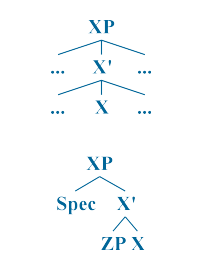Parameters

The X-bar scheme is assumed to be part of the human cognitive system, specifically of Universal Grammar, and hence to be language-independent. X-bar theory then has to account for two things:
-
The linear ordering of adjuncts, specifiers, and complements with respect to the head varies across languages. Head-complement ordering is one way to classify languages:
- Particular languages exhibit a specific ordering pattern.
X-bar theory solves this problem by stating that Universal Grammar determines hierarchical relations between constituents. The generalized rule system allows modifiers to precede or follow the head, providing a set of options for the linear ordering of elements.
Each language uses a specific subset of these options. Children acquiring a particular language select one of the options in a rule (or both), based on the input they receive. In other words, they adjust the ordering parameters for specifiers, adjuncts, and complements to the settings of their language (e.g. the parameters for PDE).
A recent alternative account proposes that Universal Grammar contains a fixed base order in which specifiers precede the head and complements follow the head. Divergent orders are then generated by additional movement (e.g. leftward movement of the object across the verb for SOV languages).
